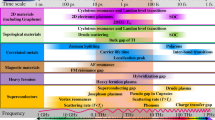Abstract
The interaction between tunneling system inherent in amorphous solids is established to be responsible for the universal behavior of their kinetics and thermodynamic properties at low temperature. In this paper, we describe the relaxation mechanism induced by the interaction that falls down as R−3 at large distances. This interaction is either the electrostatic dipole-dipole one or is the elastic one between the point defects (the tunneling system). In the last case, the interaction is due to an indirect interaction induced by acoustic virtual phonon exchange. The relaxation becomes significant at sufficiently low temperature where phonons are substantially frozen out. We show that, in a realistic experimental situation, the measuring field strongly accelerates the interaction-stimulated relaxation. The characteristic temperature and field dependences of the relaxation rate are found when the rate is affected both by the interaction between tunneling systems and by the external field.
Similar content being viewed by others
References
P. W. Anderson, B. I. Halperin, and C. M. Varma, Philos. Mag. 25, 1 (1972); W. A. Phillips, J. Low Temp. Phys. 7, 351 (1972).
L. Bernard, L. Piche, G. Schumacher, and J. Joffrin, J. Low Temp. Phys. 45, 411 (1979); G. Baier and M. V. Schickfus, Phys. Rev. B 38, 9952 (1988).
B. Golding and T. E. Graebner, in Amorphous Solids, Ed. by W. A. Phillips (Springer, Berlin, 1984), Topics in Current Physics, Vol. 24, p. 107.
P. Esquinazi, R. König, and F. Pobell, Z. Phys. B 87, 305 (1992).
S. Rogge, D. Natelson, and D. D. Osheroff, Phys. Rev. Lett. 76, 3136 (1996).
J. Classen, T. Burkert, C. Enss, and S. Hunklinger, Phys. Rev. Lett. 84, 2176 (2000).
M. A. Continentino, Phys. Rev. B 22, 6127 (1980); C. C. Yu, Phys. Rev. B 32, 4220 (1985); S. V. Maleev, Sov. Phys. JETP 67, 157 (1988); A. Würger and D. Bodea, Chem. Phys. 296, 301 (2004).
A. L. Burin and Yu. Kagan, Zh. Éksp. Teor. Fiz. 106, 633 (1994) [JETP 79, 347 (1994)].
S. Hunklinger and A. K. Raychaudchary, Prog. Low Temp. Phys. 9, 267 (1986).
W. Arnold and S. Hunklinger, Solid State Commun. 17, 833 (1975).
J. L. Black and B. I. Halperin, Phys. Rev. B 16, 2819 (1968).
S. Volker, J. Lumin. 36, 251 (1987).
H. Maier, R. Wunderlich, D. Haarer, et al., Phys. Rev. Lett. 74, 5252 (1995).
K. Fritsch and J. Friedrich, Physica D (Amsterdam) 107, 218 (1997).
J. E. Grabner and B. Golding, Phys. Rev. B 19, 964 (1979).
D. J. Salvino, S. Rogge, B. Tigner, and D. D. Osheroff, Phys. Rev. Lett. 73, 268 (1994).
A. L. Burin, J. Low Temp. Phys. 100, 309 (1995).
C. Enss and S. Hunklinger, Phys. Rev. Lett. 79, 2831 (1997).
P. Strehlow, C. Enss, and S. Hunklinger, Phys. Rev. Lett. 80, 5361 (1998).
S. Kettemann, P. Fulde, and P. Strehlow, Phys. Rev. Lett. 83, 4325 (1999).
P. Strehlow, M. Wohlfahrt, A. G. M. Jansen, et al., Phys. Rev. Lett. 84, 1938 (2000).
M. Wohlfahrt, P. Strehlow, C. Enss, and S. Hunklinger, Europhys. Lett. 56, 690 (2001).
A. Würger, Phys. Rev. Lett. 88, 075502 (2002).
J. Le Cochec, F. Ladieu, and P. Pari, Phys. Rev. B 66, 064203 (2002).
P. W. Anderson, Phys. Rev. 109, 2041 (1958).
B. D. Laikhtman, Phys. Rev. B 31, 490 (1985).
I. Ya. Polishchuk, L. A. Maksimov, and A. L. Burin, JETP 79, 634 (1994).
B. I. Shklovskii and A. L. Efros, Electronic Properties of Doped Semiconductors (Nauka, Moscow, 1979; Springer, Heidelberg, 1984).
J. J. Freeman and A. C. Anderson, Phys. Rev. B 34, 5684 (1986); A. J. Leggett and C. C. Yu, Comments Condens. Matter Phys. 14, 231 (1989).
A. L. Burin, D. Natelson, D. D. Osheroff, and Yu. Kagan, in Tunneling Systems in Amorphous and Crystalline Solids, Ed. by P. Esquinazi (Springer, Berlin, 1998), Chap. 5, p. 243.
A. L. Burin, Yu. Kagan, and I. Ya. Polishchuk, Phys. Rev. Lett. 86, 5616 (2001).
L. S. Levitov, Phys. Rev. Lett. 64, 547 (1990); Ann. Phys. (Leipzig) 8, 697 (1999).
A. L. Burin, Yu. Kagan, L. A. Maksimov, and I. Ya. Polishchuk, Phys. Rev. Lett. 80, 2945 (1998).
A. L. Burin, L. A. Maksimov, and I. Ya. Polishchuk, JETP Lett. 49, 784 (1989).
R. König, M. A. Ramos, I. Usherov-Marshak, et al., Phys. Rev. B 65, 180201 (2002).
Yu. Kagan and L. A. Maksimov, Zh. Éksp. Teor. Fiz. 87, 348 (1984) [Sov. Phys. JETP 60, 201 (1984)].
E. J. Thompson, G. Lawes, J. M. Parpia, and R. O. Pohl, Phys. Rev. Lett. 84, 4601 (2000).
F. Ladieu, J. Le Cochec, P. Pari, et al., Phys. Rev. Lett. 90, 205501 (2003); J. Le Cochec and F. Ladieu, Eur. Phys. J. B 32, 13 (2003).
S. Ludwig and D. D. Osheroff, Phys. Rev. Lett. 91, 105501 (2003).
Author information
Authors and Affiliations
Additional information
From Pis’ma v Zhurnal Éksperimental’no\(\overset{\lower0.5em\hbox{$\smash{\scriptscriptstyle\smile}$}}{l} \) i Teoretichesko\(\overset{\lower0.5em\hbox{$\smash{\scriptscriptstyle\smile}$}}{l} \) Fiziki, Vol. 80, No. 7, 2004, pp. 583–592.
Original English Text Copyright © 2004 by Burin, Maksimov, Polishchuk.
This article was submitted by the authors in English.
Rights and permissions
About this article
Cite this article
Burin, A.L., Maksimov, L.A. & Polishchuk, I.Y. Relaxation in glasses at low temperatures. Jetp Lett. 80, 513–522 (2004). https://doi.org/10.1134/1.1839302
Received:
Issue Date:
DOI: https://doi.org/10.1134/1.1839302




